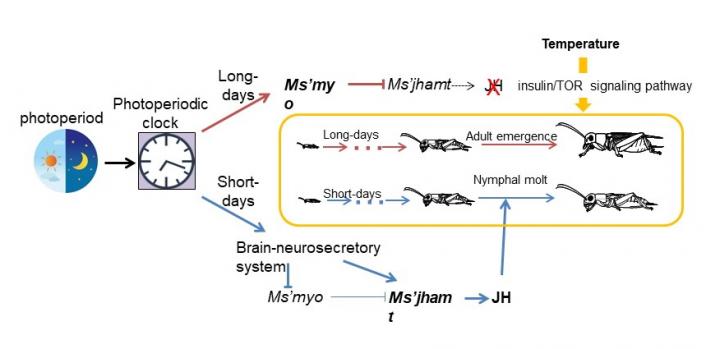Scientists show how day length and temperature play separate roles in the seasonal adaptation of some insects

Credit: 2020 Okayama University
The life cycle of insects consists of specific developmental stages. But, in response to adverse conditions, such as harsh winters, some insects arrest their own development at a particular stage. This process of seasonal adaptation is called “overwintering,” in which the growth rate of the insect is either reduced or halted. This mechanism helps the insect to cope with extreme conditions that are unsuitable for its growth and reproduction. Overwintering usually occurs at a species-specific developmental stage. For example, some insects, such as silk moths, butterflies, and fresh flies, go through diapauses in the “embryo” or “pupal” stage (developmental stages in which the insect is still immature). In such insects, this process has been extensively studied. But, in some insects that go through this arrest at the “nymphal” stage (another type of stage in which the insect is still immature), the exact details of this process have been unclear until now.
In a study published in PNAS, a research group, led by at Dr Kenji Tomioka of Okayama University, dug deeper into how developmental arrest occurs at the nymphal stage. They studied this process in a species of cricket, called Modicogryllus siamensis, in which the growth arrest phase occurs once a year in the nymphal stage. The scientists also knew that in this stage, the insect shows “photoperiodic” responses (meaning that it responds to the length of days). Dr Tomioka explains, “Although photoperiod and temperature are known to regulate this change, the underlying mechanism remains unknown. The cricket Modicogryllus siamensis ‘overwinters’ as nymphs, with a reduced growth rate and increased molts.”
A nymph develops into its adult form approximately 60 days after it hatches from the egg under long-day conditions. During its developmental process, it undergoes about 8 molts (a process in which the insect sheds its exoskeleton). Under short-day conditions, the nymphal period is longer with an increased number of molts, which helps in the overwintering process. Exactly how this happens was the question. To begin with, the scientists wanted to see how the nymphal period of slow growth is regulated by temperature. They found that low temperatures led to the reduced expression of two genes, insulin-like peptide (Ms’Ilp) and Target of rapamycin (Ms’Tor), which are part of the pathway that promotes the growth cycle in insects (the “insulin/TOR signaling” pathway). Interestingly, the scientists found that a suppression of these genes leads to a slowdown of growth in the insect, without even affecting the number of molts.
Next, the scientists focused on how day length regulates the growth arrest in insects. They uncovered that an intracellular pathway, called “the juvenile hormone (JH) pathway,” controls how day length affects the growth and molting numbers of the insect. Based on these findings, the researchers conclude that the JH signaling pathway and the temperature-controlled insulin/TOR pathway work in tandem to regulate nymphal development to achieve seasonal adaptation in this cricket.
These findings not only deepen our understanding on the mechanism of seasonal adaptation in certain insects but also shed light on the insect’s evolutionary strategy to survive in temperate areas, where day length and temperature change seasonally. Dr Tomioka concludes, “Our study was the first to show that nymphal development in an insect was controlled by two distinct mechanisms. Although much remains to be known regarding these mechanisms, we aim to gain this insight through further research.”
###
Media Contact
Kenji Tomioka
[email protected]
Related Journal Article
http://dx.




